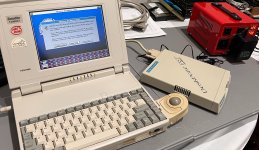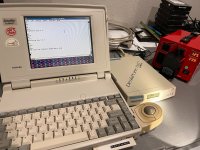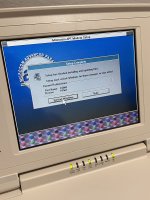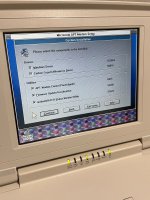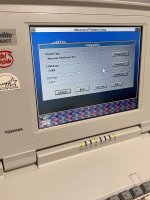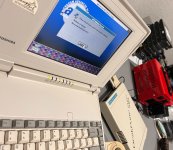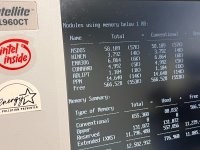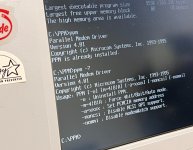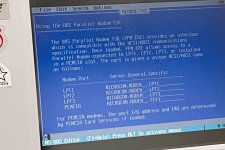voidstar78
Veteran Member
I got an unopened Microcom DeskPorte FAST+ that is from early 1990s era (1993-ish, or at least pre-Win95 era since it only has Win3.x drivers).
The use-case seems to be that if you had an old system (say <10MHz) stuck with a ~1.8MHz clocked 8250-UART, you could use this "parallel port modem" to accelerate the system-to-modem speed. The serial card on the original 4.77Mz PCs were notorious for being limited to 9600 baud (but that was related to a bug in the original system BIOS). But there may be a set of other slow systems (e.g. early 4 or 8MHz x86 laptops) with a weak integrated UART that also couldn't muster past 9600 baud [ but were performant enough to run Windows 3.x ?? ]
I decided to see if it even worked and what I could do with it. This particular one uses 240VAC, which I happened to have an appropriate power adapter for that. And I happened to have an old 486 that still has WFW3.11 installed. After installing the Microcom driver and setup, it creates a "virtual COM port" (I initially set it to use COM8 and later easily changed that to COM4 with their config software), but this relays the data across the designated LPT port.
So for modem communication, it's two stages: the byte has to get tossed over to the modem, then the modem encodes that into an audio signal. So there are two bottlenecks: how fast the host system can toss the data over to the modem, and how fast the modem can encode the signal and squawk it out. It's often 1:1 but for older/slower systems, a "fast modem" could outperform the hosts' serial port. For a pre-PCMCIA laptop, it might be hard to upgrade its serial-port parts. Or for a slow corporate office desktop, they might not permit you to crack open its case. But if you didn't need a printer, you could hijack the parallel port to speed up the host-to-modem exchange with a "parallel port modem."
Per the Microcom manual, this parallel port modem has an "autobaud" feature - where as soon as you type in the terminal, it automatically figures out what your host system baud rate is. However my install of WFW3.11 Terminal program only let me set up to 19200 baud - I didn't get time yet to install an alternative terminal program (Procomm for Windows for example). But even with this, I was getting "OK" responses from this modem.
This modem does also have a serial connection also. So I was hoping there was some kind of "relay mode" between the parallel-port side and its serial-port side. If it did, then I imagined we could use this thing as a kind of "externally attached high speed serial port" on an old system - but so far I don't think it has a mode for that. (and the manual says it prioritizes on detecting the parallel port connection, and if found, then it disables the serial connection side).
So I'm not sure what else this could be used for. Has anyone made a kind of "phone network emulator" that we can plug in phone cables? I know we could just setup LAPlink parallel cables between two systems. But I'm still curious to see if this "Virtual COM port" concept works.
The use-case seems to be that if you had an old system (say <10MHz) stuck with a ~1.8MHz clocked 8250-UART, you could use this "parallel port modem" to accelerate the system-to-modem speed. The serial card on the original 4.77Mz PCs were notorious for being limited to 9600 baud (but that was related to a bug in the original system BIOS). But there may be a set of other slow systems (e.g. early 4 or 8MHz x86 laptops) with a weak integrated UART that also couldn't muster past 9600 baud [ but were performant enough to run Windows 3.x ?? ]
I decided to see if it even worked and what I could do with it. This particular one uses 240VAC, which I happened to have an appropriate power adapter for that. And I happened to have an old 486 that still has WFW3.11 installed. After installing the Microcom driver and setup, it creates a "virtual COM port" (I initially set it to use COM8 and later easily changed that to COM4 with their config software), but this relays the data across the designated LPT port.
So for modem communication, it's two stages: the byte has to get tossed over to the modem, then the modem encodes that into an audio signal. So there are two bottlenecks: how fast the host system can toss the data over to the modem, and how fast the modem can encode the signal and squawk it out. It's often 1:1 but for older/slower systems, a "fast modem" could outperform the hosts' serial port. For a pre-PCMCIA laptop, it might be hard to upgrade its serial-port parts. Or for a slow corporate office desktop, they might not permit you to crack open its case. But if you didn't need a printer, you could hijack the parallel port to speed up the host-to-modem exchange with a "parallel port modem."
Per the Microcom manual, this parallel port modem has an "autobaud" feature - where as soon as you type in the terminal, it automatically figures out what your host system baud rate is. However my install of WFW3.11 Terminal program only let me set up to 19200 baud - I didn't get time yet to install an alternative terminal program (Procomm for Windows for example). But even with this, I was getting "OK" responses from this modem.
This modem does also have a serial connection also. So I was hoping there was some kind of "relay mode" between the parallel-port side and its serial-port side. If it did, then I imagined we could use this thing as a kind of "externally attached high speed serial port" on an old system - but so far I don't think it has a mode for that. (and the manual says it prioritizes on detecting the parallel port connection, and if found, then it disables the serial connection side).
So I'm not sure what else this could be used for. Has anyone made a kind of "phone network emulator" that we can plug in phone cables? I know we could just setup LAPlink parallel cables between two systems. But I'm still curious to see if this "Virtual COM port" concept works.

